Introduction
Hey there rabbit owners! Are you looking for the ultimate guide to maintaining straw bedding for your furry friends?
As a fellow rabbit enthusiast, I understand the importance of providing our fluffy companions with a comfortable and clean living space. That’s why I’ve put together this comprehensive article to help you master the art of straw bedding maintenance for your rabbits.
We’ll start off by diving into the reasons why straw bedding is essential for rabbits. From insulation and cushioning to moisture absorption, straw bedding plays a vital role in ensuring the comfort and well-being of our furry friends.
You’ll also find some great tips for keeping the straw bedding dry, checking for pest infestations, and providing enrichment options for your rabbits.
We’ll also tackle the topic of proper straw bedding preparation in a step-by-step tutorial. You’ll learn how to gather the necessary materials, prepare the area, fluff the straw, spread it evenly, and create comfortable nesting areas for your rabbits.
Next up, we’ll address the question of whether there are better bedding options than straw for rabbits. We’ll explore various alternatives such as hay, paper-based beddings, and fleece liners, discussing their pros and cons.
And of course, we can’t ignore the importance of choosing the best straw bedding for your rabbits. We’ll dive into the factors to consider when selecting straw bedding, such as dust content, freshness, comfort, absorbency, availability, and cost.
So, whether you’re a seasoned rabbit owner looking to up your straw bedding game or a new bunny parent in need of some guidance, this article is here to help. Get ready to provide your rabbits with the coziest and most comfortable straw bedding they’ve ever had.
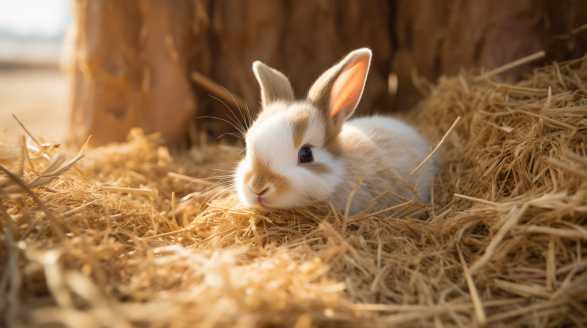
Key Takeaways
- Straw bedding is essential for rabbits as it provides insulation, comfort, and moisture absorption.
- Maintaining straw bedding involves choosing the right straw, regular cleaning, and replacing dirty straw. Fluffing the bedding and checking for pests are also important.
- Proper preparation of straw bedding involves gathering materials, preparing the area, fluffing the straw, spreading it evenly, and creating comfortable nesting areas.
- There are alternative bedding options to straw, such as hay, paper-based beddings, and fleece liners.
- When choosing straw bedding, consider dust content, freshness, comfort, absorbency, availability, and cost. Wheat straw, barley straw, and oat straw are common types.
- Straw bedding provides several benefits, including comfort, insulation, odor control, and ease of cleaning. It is also natural and safe for rabbits.
- Straw bedding is not suitable for baby rabbits as it can be chewed on and is not as absorbent or comfortable as other bedding options.
- Choosing the right size and thickness of straw bedding is important for providing ample space, comfort, and insulation for rabbits. Aim for a minimum depth of 3-4 inches and a thickness of 4-6 inches for optimal results.
The Importance of Proper Straw Bedding Maintenance for Rabbits
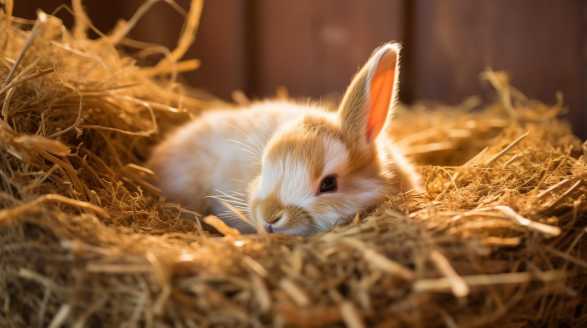
As a rabbit owner, I understand the importance of maintaining the straw bedding for our furry friends. Proper care and maintenance of the bedding not only ensure the comfort and well-being of our rabbits but also contribute to their overall health.
Why Straw Bedding?
Straw bedding serves as an essential component of a rabbit’s habitat. It provides insulation, cushioning, and a comfortable resting place for your rabbits to curl up in.
Step-by-Step Guide to Maintaining Straw Bedding
- Choose the Right Straw: Start by selecting a high-quality straw for your rabbit’s bedding. Avoid straw that appears moldy or has a strong odor, as these can cause respiratory issues for your rabbits.
- Cleaning Routine: Establish a regular cleaning routine to keep the straw bedding fresh. Daily spot-cleaning of any soiled areas with a scoop or shovel will help maintain proper hygiene.
- Remove Waste: Regularly remove any droppings or urine-soaked straw from the bedding. This prevents the buildup of ammonia and keeps your rabbits’ living environment clean and healthy.
- Replace Dirty Straw: When the straw becomes too soiled or wet, it’s time to replace it. Remove the dirty straw from the enclosure and dispose of it properly. Replace it with fresh, clean straw to ensure your rabbits have a comfortable and clean living space.
- Fluff the Bedding: After replacing the straw, fluff it up to restore its texture and provide a soft surface for your rabbits. This will help maintain their comfort and prevent any potential discomfort or injuries.
- Check for Signs of Pest Infestation: Regularly inspect the straw bedding for signs of pests, such as fleas or mites. If you notice any indicators of infestation, take prompt action to remove the pests and prevent any harm to your rabbits.
Tips for Maintaining Straw Bedding
To ensure the best care for your rabbits and their straw bedding, consider the following tips:
Keep the Bedding Dry
- Moisture can lead to the growth of bacteria and mold, which can be harmful to rabbits. Take measures to keep the straw bedding dry and well-ventilated.
Provide Adequate Bedding Depth
- Aim for a depth of at least 2-3 inches of straw bedding. This allows your rabbits to burrow and nest comfortably, mimicking their natural behavior.
Monitor for Signs of Allergies or Respiratory Issues
- Some rabbits may be allergic to straw bedding or may develop respiratory issues when exposed to dust. If you notice any signs of discomfort, consider alternative bedding options or consult a veterinarian for guidance.
Introduce Enrichment Options
- Offer your rabbits additional enrichment options within their straw bedding, such as chew toys, tunnels, or foraging toys. This stimulates their natural instincts and keeps them mentally and physically active.
Regularly Inspect the Bedding Area
- Apart from checking the straw bedding itself, examine the surrounding area for any potential hazards or spills that may affect the cleanliness and safety of your rabbits’ habitat.
Avoid Nesting in One Corner
- Rabbits tend to nest in one area, which can result in excessive soiling and unsanitary conditions. Encourage your rabbits to distribute their nest throughout the enclosure by providing multiple hiding spots or cozy resting areas.
Seek Professional Advice if Needed
- If you encounter any challenges or have specific concerns about maintaining straw bedding, do not hesitate to seek advice from a veterinarian or an experienced rabbit caretaker. They can offer invaluable guidance tailored to your rabbit’s individual needs.
By following these tips and maintaining a regular cleaning routine, you ensure that your rabbits’ straw bedding remains comfortable, clean, and conducive to their overall well-being.
Proper straw bedding maintenance is crucial for the health and happiness of our furry companions. By choosing high-quality straw, implementing a cleaning routine, and providing enrichment, we create a safe and comfortable environment for our rabbits.
So, grab your scoop and fluff up that bedding, your rabbits will thank you for it!
Step-by-Step Tutorial: How to Prepare Straw Bedding for Rabbits
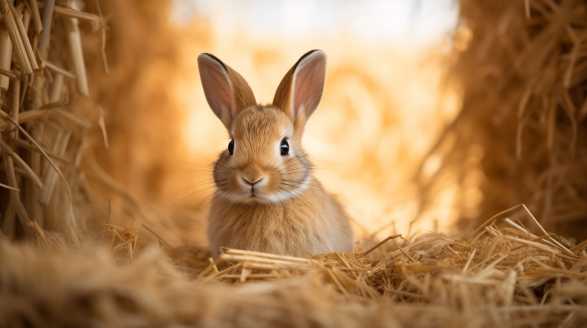
Raising rabbits is a delightful experience that requires careful attention to their well-being and comfort. One crucial aspect of keeping rabbits happy and healthy is providing them with proper bedding.
So, let’s get started!
Gather the Materials
To prepare straw bedding for your rabbits, you will need a few essential materials. Make sure you have these items ready before you begin:
- Straw: Choose straw made from wheat, barley, or oats, as it is the most suitable type for rabbit bedding. Avoid using hay, as it can be too dusty for rabbits.
- Plastic tarp or a large bin/container: You’ll need a clean, dry surface to work on and contain the straw.
- Gloves and face mask: These will help protect you from any allergens or dust while handling the straw.
- A pitchfork or hayfork: This tool will be handy for fluffing and spreading the straw.
Preparing the Area
Before you begin, make sure the area where you’ll be preparing the straw bedding is clean and well-ventilated. It’s best to do this task outdoors or in a well-ventilated area, as the straw may release some dust particles.
- Lay down the plastic tarp or prepare the large bin to contain the straw.
- Put on your gloves and face mask to protect yourself.
Fluffing the Straw
Fluffing the straw helps separate the stalks, making it easier for the rabbits to burrow and create comfortable nests. Follow these steps to fluff the straw:
- Take a handful of straw and loosen it by separating the stalks gently. Fluff it up to create more volume.
- Continue this process with each handful of straw until you have fluffed the desired amount of straw for your rabbit’s bedding. Remember, rabbits love to burrow, so having enough fluffy straw is essential.
Spreading the Straw
Spreading the straw evenly ensures that the rabbits have ample space to move around and build their nests. Here’s how you can spread the straw properly:
- Using a pitchfork or hayfork, start distributing the fluffed straw onto the prepared area.
- Create a layer of straw at least 2 to 3 inches thick. This will provide enough insulation and cushioning for your rabbits.
Nesting Areas
Rabbits like to have cozy spots for nesting and resting. Creating designated nesting areas within the straw bedding is essential.
- Use your hands to create a hollow depression in the straw, about the size of your rabbit, where they can comfortably sit and rest.
- Ensure that these nesting areas are spread out throughout the bedding area, maintaining enough space for each rabbit.
Regular Maintenance
Maintaining the straw bedding is vital to keep your rabbits healthy and comfortable. Follow these steps for regular upkeep:
- Spot clean the straw bedding regularly by removing any soiled or wet areas that may cause odors.
- Replace the soiled straw with fresh straw to maintain cleanliness and prevent discomfort for your rabbits.
- Check the bedding for signs of excessive dampness, as rabbits are sensitive to moisture. If needed, rotate and fluff the straw to allow proper drying.
Providing rabbits with a well-prepared straw bedding is essential for their overall well-being and comfort. By following this step-by-step tutorial, you now have the knowledge to create a cozy and inviting environment for your beloved rabbits.
Happy rabbit keeping!
Understanding the Differences: Straw vs Hay Bedding for Rabbits
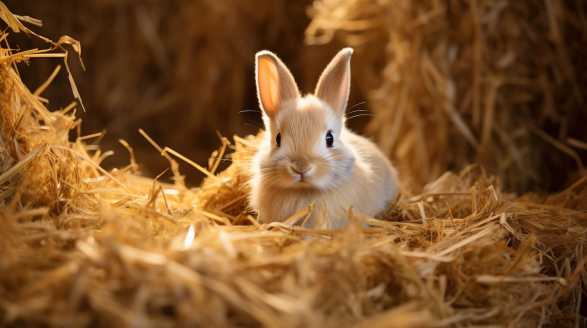
As a rabbit owner, one of the crucial decisions you have to make is choosing the right bedding for your furry friend’s comfort. Two popular options are straw and hay bedding.
I will break down everything you need to know about straw and hay bedding for rabbits.
Straw Bedding
Straw bedding is derived from dried stalks of various grain plants, such as wheat, barley, or oats. It is commonly used as bedding material for livestock, including rabbits.
- Comfort Level:
- Straw bedding provides moderate comfort for rabbits. It offers some cushioning and insulation to keep them cozy.
- Absorbency:
- Unlike wood shavings or paper bedding, straw is not as absorbent. It tends to retain moisture, which can lead to an unpleasant odor and potentially cause health issues for your rabbit.
- Durability:
- Straw bedding is relatively durable and can last longer than other options. However, it may become compressed and less comfortable with time.
- Availability:
- Straw bedding is easily accessible and can be found at most pet stores and farm supply shops. It is also more affordable compared to other bedding options.
- Harmful Substances:
- Keep in mind that straw bedding often contains small amounts of dust and potential allergens. This can be particularly problematic for rabbits with respiratory sensitivities.
Hay Bedding
Hay bedding, on the other hand, is made from dried grasses, such as timothy hay, orchard grass, or meadow grass. Here’s what you need to know about hay bedding:
- Comfort Level:
- Hay bedding offers excellent comfort for rabbits since it is soft, warm, and mimics their natural habitat. It provides a cozy environment for your furry friend to rest and play.
- Absorbency:
- Hay bedding is more absorbent than straw. It absorbs moisture efficiently, keeping the rabbit’s living area dry and odor-free for a longer duration.
- Nutritional Value:
- Unlike straw, hay is an essential dietary component for rabbits. It provides nutritional value, necessary fiber, and aids their digestive system. Rabbits will naturally graze on the hay while using it as bedding.
- Availability:
- Hay bedding is widely available at pet stores, farm supply shops, and online retailers. However, it can be slightly more expensive compared to straw bedding.
- Allergenic Properties:
- While hay is generally safe for rabbits, some individuals may be allergic to certain types of hay. It’s important to observe your rabbit for any signs of allergies or discomfort.
Choosing the Right Bedding
Now that you understand the characteristics of both straw and hay bedding, you might be wondering which one is the best choice for your rabbit. Consider the following factors when making your decision:
- Comfort Needs:
- Does your rabbit prefer a softer and more cushioned bed? If so, hay bedding might be the ideal choice. However, if your rabbit is not particularly picky, straw bedding can still provide adequate comfort.
- Odor Control:
- If you prioritize odor control, hay bedding is the superior option. Its absorbency properties help maintain a fresher-smelling environment for both you and your rabbit.
- Budget Considerations:
- Straw bedding is more cost-effective compared to hay bedding. If you’re on a tight budget, straw could be a suitable choice without compromising your rabbit’s well-being.
- Health Concerns:
- If your rabbit has respiratory issues, it’s advisable to avoid straw bedding due to potential allergens. Opt for hay bedding instead, as it tends to be safer in this regard.
Both straw and hay bedding offer different advantages for rabbit owners. While straw bedding is more readily available and affordable, hay bedding provides superior comfort, absorbency, and nutritional benefits for your furry friend.
Ultimately, ensuring a comfortable and clean environment is essential for your rabbit’s well-being and happiness.
How to Keep Rabbits Warm in Winter with Straw Bedding
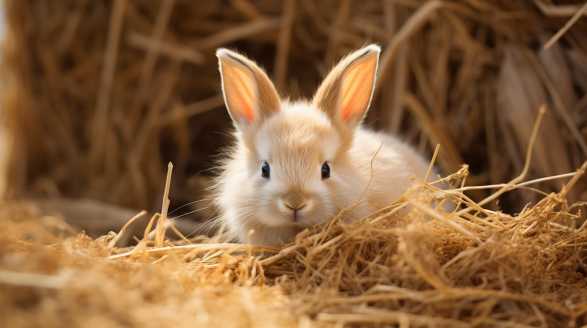
As a proud rabbit owner, one of my primary concerns during winter is how to keep my furry friends warm and comfortable. Rabbits are sensitive creatures and can easily suffer from the cold temperatures, making it essential to provide them with proper bedding and insulation.
I will share my insights, tips, and recommendations to ensure your rabbits have a cozy winter home.
Why Straw Bedding?
Rabbits are burrowers by nature, and they love nesting and snuggling into cozy, warm spaces. Straw bedding is an excellent choice for winter as it provides insulation, warmth, and comfort.
Additionally, it is absorbent and helps reduce moisture, preventing your rabbits from getting damp and cold.
Preparing the Rabbit Hutch
Before we dive into straw bedding techniques, it’s crucial to prepare the rabbit hutch for winter. Here are some key steps to follow:
- Seal any gaps or drafts: Inspect the hutch thoroughly and seal any openings that might allow cold air to seep in.
- Elevate the hutch: If possible, raise the hutch to prevent it from sitting directly on the cold ground. This helps prevent heat loss through conduction.
- Position away from wind: Place the hutch in a sheltered area, away from strong winds and excessive exposure to rain or snow.
- Provide adequate ventilation: Although you want to keep your rabbits warm, it’s essential to balance it with proper ventilation to avoid condensation, which can lead to respiratory issues. Ensure there are air vents that allow fresh air circulation without creating drafts.
Choosing the Right Straw Bedding
Not all straw is created equal when it comes to rabbit bedding. Here are a few things to consider when selecting the ideal straw:
- Wheat straw: This type of straw is widely used for bedding due to its availability and affordability. It’s soft, clean, and offers excellent insulation properties.
- Barley straw: Barley straw is another suitable option, but it can be slightly scratchy for rabbits with sensitive skin. If using barley straw, make sure to fluff it up to soften it before placing it in the hutch.
- Avoid damp or moldy straw: Always ensure the straw is dry, clean, and free from mold. Damp straw can lead to respiratory issues and discomfort for your rabbits.
- Consider straw with seed heads: Straw containing seed heads adds an extra layer of enrichment for rabbits as they enjoy foraging and nibbling on them.
Proper Straw Bedding Technique
Now that you have selected the ideal straw bedding, it’s time to prepare the rabbit hutch for a warm winter home. Follow these steps for optimal results:
- Layer the floor: Start by placing a thick layer of newspapers or cardboard as a base to protect the floor and prevent it from getting damp.
- Spread a generous amount of straw: Cover the floor with a thick layer of straw. Aim for at least 4-6 inches to provide ample cushioning and insulation.
- Create a cozy nest area: Rabbits love having a specific warm spot to snuggle in. Gather a bunch of straw and create a mound in one corner of the hutch to serve as a nest area.
- Monitor and replenish regularly: Check the straw bedding daily and replenish when necessary. Over time, rabbits may move, eat, or nestle into some of the straw, so ensure they always have a warm and cozy area available.
Additional Tips for Keeping Rabbits Warm
Aside from using straw bedding, here are some additional tips to help keep your rabbits warm throughout the winter:
- Insulating the hutch: Consider adding insulation material around the hutch, such as polystyrene or insulation panels. This provides extra protection against the cold weather.
- Use heat pads or bottles: If the temperatures drop significantly, you can place microwaveable heat pads or hot water bottles covered with a towel in the hutch. However, ensure they are well-covered and positioned in such a way that your rabbits cannot chew on them.
- Provide additional bedding materials: Add extra layers of hay and blankets to specific areas of the hutch, especially where your rabbits rest or sleep. This increases insulation and provides additional warmth.
- Adjust outdoor time: While it’s crucial for rabbits to have some outdoor time, limit their exposure to extremely cold temperatures. Try to schedule playtime and exercise during the warmer parts of the day.
By utilizing straw bedding and following the tips mentioned above, you can ensure your rabbits stay warm and cozy during the winter months. Remember to regularly monitor and adjust the bedding as needed, and always prioritize the comfort and health of your furry companions.
Stay warm!
Exploring Alternatives: Are There Better Bedding Options than Straw for Rabbits?
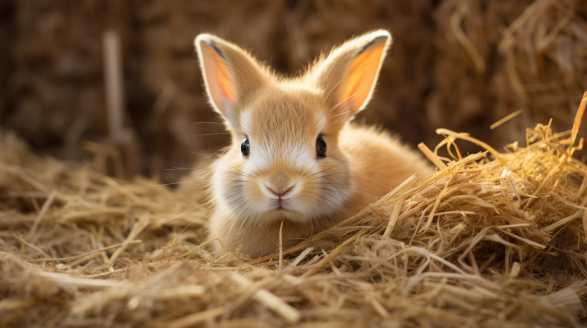
As a rabbit owner, I have always wanted the best for my furry friend. One area that I found myself pondering was whether there are better bedding options available for rabbits than straw.
I will look into these options, exploring their pros and cons, to help fellow rabbit enthusiasts make informed choices for their beloved pets.
1. Hay – The Versatile and Natural Option
When it comes to bedding for rabbits, hay is undoubtedly the most popular and widely used choice. Here are some reasons why:
- Comfort: Rabbits love burrowing and snuggling into soft bedding, and high-quality hay serves this purpose perfectly.
- Digestive Health: Hay plays a crucial role in maintaining a rabbit’s digestive system, aiding in dental wear and ensuring a healthy gut.
- Absorbency: While not as absorbent as some other options on this list, hay does offer moderate urine absorption properties.
- Availability: Hay is readily available in pet stores, farm supply shops, and even online.
2. Paper-Based Beddings – Go Green with a Twist!
If you are looking for eco-friendly alternatives to straw, various paper-based beddings can make your environmentally conscious heart leap with joy. Here are a few options to consider:
- Shredded Paper: Recycling old newspapers and shredding them into smaller bits can create a comfortable and economical bedding option for your rabbit. Just ensure that the ink used is soy-based and non-toxic.
- Paper Pellets: Made from recycled paper, these compressed pellets are highly absorbent and reduce both odor and waste. However, some rabbits may find them less comfortable to rest on.
3. Timothy-Based Beddings – A Nutritional Boost
Timothy-based beddings offer an added nutritional benefit to your rabbit’s bedding experience. These types of bedding are typically made from compressed timothy grass, providing a tasty and enriching experience for your furry friend.
4. Fleece Liners – Soft and Reusable
For rabbit owners seeking a more convenient and reusable option, fleece liners may be the ultimate choice. Here’s why they are gaining popularity among rabbit enthusiasts:
- Softness: Fleece liners provide a cozy and comfortable environment for rabbits to rest and play on.
- Absorbency: By using an absorbent layer beneath the fleece, these liners can effectively manage urine and keep the surface dry.
- Reusable and Cost-effective: Fleece liners can be washed and reused multiple times, making them an economical option over the long run.
5. Hemp Bedding – The All-natural Alternative
Hemp bedding, derived from the industrial hemp plant, is gaining traction as a healthier alternative to traditional straw bedding. Here are some of its notable qualities:
- Moisture Absorption: Hemp bedding can absorb moisture exceptionally well, keeping the rabbit’s living space clean and odor-free.
- Pest Control: Hemp is naturally resistant to many pests, reducing the chances of harboring unwanted guests in your rabbit’s habitat.
- Sustainable and Eco-friendly: Hemp is a highly renewable resource, making it a more sustainable choice compared to other bedding options.
6. Wood Shavings – A Classic, but with a Caution
Wood shavings bedding has been a staple for many pet owners, including rabbit enthusiasts, for quite some time. However, there are a few considerations to bear in mind when using this option:
- Avoid Cedar and Pine: Certain types of wood, such as cedar and pine, can emit harmful aromatic oils that might lead to respiratory issues in rabbits. Opt for safer alternatives like aspen or kiln-dried pine.
- Great Absorption: Wood shavings offer excellent absorption properties, keeping your rabbit’s living area dry and minimizing odors.
- Watch for Splinters: Check for any sharp or large splinters that could potentially harm your rabbit. A safe option is using smaller, finer wood shavings.
While straw may be the traditional choice for rabbit bedding, exploring alternatives can open up a world of opportunities to enhance your furry friend’s comfort and well-being. Whether you opt for the natural goodness of hay, eco-friendly paper-based bedding, or the versatility of fleece liners, there are numerous options to suit both your rabbit’s needs and your personal preferences.
By prioritizing your rabbit’s health and happiness, you are sure to find a bedding solution that your fluffy companion will appreciate.
The Benefits of Using Straw Bedding for Rabbits
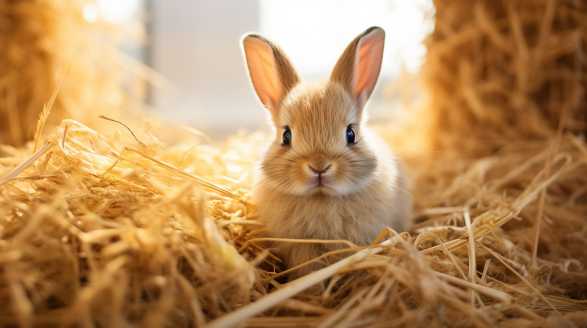
As a long-time rabbit owner and enthusiast, I have discovered that using straw bedding for rabbits offers a multitude of benefits. From providing comfort to improving hygiene, straw bedding is a practical and cost-effective choice for creating a cozy living environment for your furry friends.
Comfort Comes First
When it comes to ensuring the well-being of our beloved rabbits, providing them with a comfortable living space is paramount. Straw bedding is an excellent choice in this regard as it offers ample cushioning and insulation.
The Ideal Nesting Material
Rabbits are meticulous nest builders, especially during breeding or pregnancy periods. Straw bedding offers numerous strands that can be easily manipulated and shaped into a comfortable and warm nest.
Excellent Odor Control
One of the challenges many pet owners face is maintaining a fresh and odor-free living space. Straw bedding proves to be a practical solution, thanks to its effective odor control properties.
This leads to a fresher and more enjoyable environment for both you and your rabbits.
Proper Ventilation
Straw bedding’s ability to provide excellent airflow is yet another advantage for maintaining a hygienic rabbit habitat. The loose structure of straw allows air to circulate freely, preventing the accumulation of excess moisture.
With straw bedding, good ventilation is ensured, greatly reducing the risks associated with poor air quality.
Cost-Effective and Easy to Obtain
As pet owners, budget considerations are always a factor to keep in mind. The affordability and accessibility of straw bedding make it an attractive option.
Additionally, it is a cost-effective choice compared to more specialized bedding materials. By using straw bedding, you can provide a high level of comfort without breaking the bank.
Versatile Usage
Straw is a highly versatile material, with applications beyond just bedding. It can also serve as a natural play and foraging material for rabbits.
Rabbits can dig, toss, and munch on the straw, keeping them entertained for hours on end.
Natural and Safe
When it comes to selecting bedding materials, it’s crucial to opt for those that are safe and non-toxic for your rabbits. Straw bedding ticks all the boxes in this department.
This makes it an excellent choice, especially for rabbits prone to allergies or sensitivities.
Reduced Risk of Dust and Allergens
One of the concerns with certain bedding materials is the potential for dust and allergen accumulation. This can trigger respiratory issues in rabbits, leading to discomfort and health complications.
By choosing straw bedding, you are prioritizing the well-being of your rabbits and minimizing potential health hazards.
Easy to Clean and Replace
Maintaining cleanliness in your rabbit’s living space is vital for their health and overall well-being. Straw bedding is easy to clean, requiring minimal effort and time.
Reduces the Risk of Sore Hocks
Sore hocks, a common condition among rabbits, can be uncomfortable and painful. It occurs when their foot pads become irritated or inflamed due to prolonged contact with a hard surface.
Its soft and pliable nature reduces the pressure on your rabbit’s foot pads, mitigating the risk of sore hocks.
Aesthetically Pleasing
Creating an aesthetically pleasing living space for your rabbits not only enhances their environment but also adds a touch of charm to your home. Straw bedding provides a rustic and cozy appearance, making your rabbit’s habitat more visually appealing.
Easy Customization
The versatility of straw bedding allows for easy customization of your rabbit’s living space. You can add or remove straw as needed, depending on your pet’s preferences.
Straw bedding proves to be an excellent choice for rabbit owners due to its numerous benefits. It provides exceptional comfort, promotes good hygiene, offers odor control, and is both natural and safe for your furry companions.
By choosing straw bedding, you are ensuring the well-being and happiness of your rabbits, while simultaneously creating an attractive living space for them to thrive.
Is Straw Bedding Suitable for Baby Rabbits? A Guide for New Owners
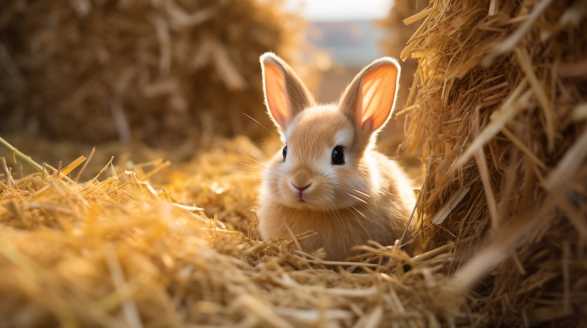
As a new owner of baby rabbits, you may find yourself overwhelmed with questions about how to properly care for these adorable and delicate creatures. One common concern is selecting the right bedding material for their living spaces.
I’ll explore whether straw bedding is suitable for baby rabbits.
Why is Choosing the Right Bedding Important?
Choosing the right bedding for baby rabbits is crucial for their overall health and well-being. A good bedding material helps maintain a clean, comfortable, and safe living environment.
Selecting unsuitable bedding may lead to health issues, discomfort, or even injuries.
Factors to Consider
Before we look into the suitability of straw bedding for baby rabbits, let’s consider a few essential factors when selecting bedding for these furry bundles of joy:
1. Safety
Safety should always be the top priority when selecting bedding for baby rabbits. They are active creatures, and their curious nature may lead to nibbling or chewing on their bedding materials.
2. Absorbency
Baby rabbits, like all young animals, are prone to accidents, especially during the litter training process. Therefore, an absorbent bedding material is essential to keep their living space clean and dry.
3. Comfort
A comfortable bedding material helps baby rabbits feel secure and relaxed. It should cushion their delicate bodies, provide insulation, and promote healthy sleep.
4. Hygiene
Maintaining good hygiene is vital to prevent the development of bacterial or fungal infections. Bedding materials that tend to retain moisture or produce strong odors should be avoided.
Is Straw Bedding Suitable?
Now that we have a clear understanding of the factors to consider when selecting bedding for baby rabbits, let’s explore whether straw fits the bill:
1. Safety
While straw itself is generally considered safe, some caution is necessary. Baby rabbits might chew on straw, potentially leading to gastrointestinal blockages or other health issues.
2. Absorbency
Straw is less absorbent compared to some other bedding materials like paper or wood shavings. It tends to allow urine to pass through to the bottom layer, leaving the surface damp.
3. Comfort
Straw bedding, with its coarse and rigid texture, may not provide the desired level of comfort for baby rabbits. They prefer softer materials that offer better cushioning and insulation for their tiny bodies.
4. Hygiene
Straw, due to its structure, has poor ventilation and can retain moisture easily. This can lead to the growth of bacteria or molds, compromising the hygiene of the living space.
Best Alternatives to Straw Bedding
Considering the limitations of straw bedding for baby rabbits, here are some better alternatives worth considering:
1. Paper Bedding
Paper bedding, such as shredded newspaper or paper pellets, is a popular and safe option for baby rabbits. It is highly absorbent, easy to clean, and provides a soft and comfortable surface.
2. Wood Shavings
Wood shavings made from kiln-dried untreated wood are another viable option. They are absorbent, comfortable, and often have good ventilation properties.
3. Hay
Hay can serve as both bedding and a source of nutrition for baby rabbits. It absorbs moisture effectively and provides a natural and cozy environment for them to nest.
4. Recyclable Pellets
Recycled paper or plant-based pellets designed for small animals offer similar benefits to paper bedding. They provide comfort, absorb moisture, and are environmentally friendly.
When it comes to selecting bedding for baby rabbits, it is crucial to prioritize their safety, comfort, absorbency, and hygiene. While straw may be readily available and affordable, it falls short in meeting the desired criteria.
Choosing the right bedding will not only promote their well-being but also enhance your overall rabbit-owning experience.
A Comprehensive Guide to Choosing the Best Straw Bedding for Rabbits
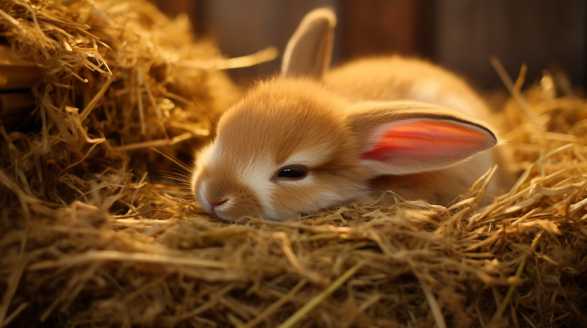
As a rabbit owner, one of the most important aspects of caring for your furry friend is providing them with a comfortable and safe bedding option. Straw bedding is commonly used for rabbits due to its affordability, availability, and ability to provide insulation and comfort.
I will share everything I know about choosing the best straw bedding for rabbits, helping you make an informed decision.
Why Choose Straw Bedding for Your Rabbit?
Straw bedding is a popular choice among rabbit owners for several reasons:
- Insulation and Comfort: Straw provides excellent insulation, keeping your rabbit cozy during colder months. It also offers cushioning and comfort, allowing your furry friend to relax and sleep soundly.
- Absorbency: Straw has decent absorbency, which helps to control odors and maintain a dry living environment for your rabbit.
- Availability and Affordability: Straw is widely available and relatively inexpensive compared to other bedding options, making it a cost-effective choice for many rabbit owners.
Factors to Consider When Choosing Straw Bedding
Now that we understand the benefits of straw bedding for rabbits, it’s important to consider a few key factors before making a purchase. Here are some aspects to keep in mind:
1. Dust Content
Excessive dust in straw bedding can cause respiratory issues for your rabbit. To ensure the bedding is safe, look for straw with minimal dust content.
2. Freshness
Choose straw bedding that is fresh and not moldy. Mold can be harmful to your rabbit’s health and lead to various respiratory problems.
3. Comfort and Cushioning
Consider the comfort and cushioning provided by the straw bedding. Rabbits love to burrow and dig, so look for bedding that is soft and allows for natural behavior.
4. Absorbency and Odor Control
Opt for straw bedding that has good absorbency to control odor and keep your rabbit’s living area clean and fresh. Straw bedding should be able to absorb urine effectively, preventing unpleasant odors from developing.
5. Availability and Cost
Check the availability and cost of different straw bedding options in your area. While straw is generally affordable, prices can vary based on location and seasonal availability.
Types of Straw Bedding
Not all straw bedding options are the same. Let’s explore some common types of straw that can be suitable for rabbit bedding:
1. Wheat Straw
Wheat straw is a popular choice for rabbit bedding due to its availability and affordability. It provides good cushioning and is relatively soft, making it comfortable for rabbits to rest on or burrow into.
2. Barley Straw
Barley straw is another readily available straw bedding option for rabbits. It is slightly coarser than wheat straw but still provides sufficient comfort and insulation.
3. Oat Straw
Oat straw is less commonly used as rabbit bedding but can still be a suitable option. It is softer and more comfortable than both wheat and barley straw.
If you can find it, it can be a great choice for rabbits with sensitive skin or those that require extra bedding comfort.
Tips for Using Straw Bedding Effectively
To ensure the best experience for your rabbit and make the most of your chosen straw bedding, consider the following tips:
- Layering: Use a thick layer of straw bedding to provide excellent insulation and comfort for your rabbit. A depth of at least a few inches is recommended.
- Spot Cleaning: While straw bedding is relatively absorbent, it’s important to spot clean regularly to maintain cleanliness and minimize odor. Remove any soiled or wet spots to keep the bedding fresh.
- Full Cage Cleaning: Perform a complete cage cleaning on a regular basis to maintain a hygienic environment for your rabbit. Replace all of the straw bedding during this process.
- Monitoring: Keep an eye on your rabbit’s behavior and overall health while using straw bedding. If you notice any signs of discomfort, allergies, or mold-related issues, consider switching to a different type of bedding.
Choosing the best straw bedding for your rabbit requires considering factors such as dust content, freshness, comfort, absorbency, availability, and cost. Wheat straw, barley straw, and oat straw are common options that offer different levels of softness and availability.
Remember to prioritize their comfort and health when making your bedding choice.
Choosing the Right Size and Thickness of Straw Bedding for Your Rabbits
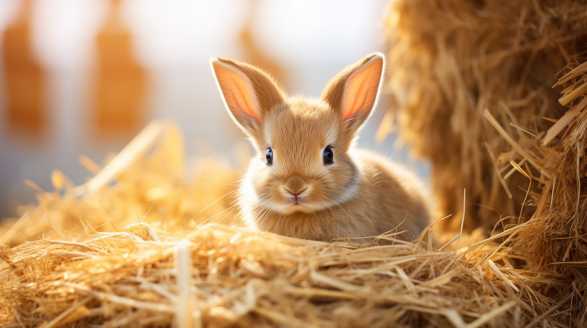
As a rabbit enthusiast, I know that providing comfortable bedding is crucial for the well-being of our furry friends. One of the most common choices for rabbit bedding is straw, thanks to its affordability, availability, and natural properties.
we will explore the various factors to consider when choosing straw bedding for your rabbits, guiding you through the decision-making process.
Why Straw Bedding?
Straw is a popular option for rabbit bedding due to many factors. It provides good insulation against cold and dampness, absorbs moisture well, and is relatively affordable compared to other types of bedding materials.
Considerations for Straw Bedding
Before diving into the specifics of size and thickness, it’s important to consider a few general factors when choosing straw bedding for your rabbits:
- Quality: Opt for high-quality straw that is clean and free of molds, dust, or pests.
- Allergies: Be cautious if any members of your family have allergies to straw or dust, as it may cause discomfort or respiratory issues.
- Accessibility: Ensure that the straw you choose is readily available in your area to avoid any inconvenience.
- Preference: Observe your rabbits’ behavior and preference towards certain types of straw bedding. Some may have specific preferences, and understanding them will help you make the right choice.
Size of Straw Bedding
Rabbits, naturally, love to burrow and create cozy nests. Hence, providing them with sufficient space to indulge in this behavior is essential to their well-being.
Here are some aspects to consider:
1. Bedding Area Size
The size of the area you dedicate to bedding is directly related to the number and size of your rabbits. Ensure each rabbit has enough space to stretch out comfortably.
This allows them to move around freely and have a dedicated area for their waste.
2. Depth
The depth of straw bedding is important to consider, as rabbits enjoy digging and burrowing. Aim for a bedding depth of at least 3 to 4 inches to provide them with ample room to indulge in their natural instincts.
Thickness of Straw Bedding
Apart from the size, the thickness of straw bedding also influences the comfort, insulation, and overall well-being of your rabbits. Here are a few factors to keep in mind:
1. Insulation
Straw bedding acts as an insulator, protecting rabbits from extreme temperatures. A thicker layer of straw provides better insulation against cold floors during winters or hot surfaces during summers.
2. Comfort
Rabbits appreciate a soft and cozy bed. A thicker layer of straw offers additional comfort and cushioning, allowing rabbits to rest and relax more comfortably.
Aim for a bedding thickness of at least 4 to 6 inches to provide optimal comfort for your rabbits.
Choosing the right size and thickness of straw bedding for your rabbits is essential to ensure their comfort, well-being, and happiness. By considering factors such as bedding area size, depth, insulation, and comfort, you can create an ideal environment for your furry friends.
Providing suitable straw bedding will not only make your rabbits feel safe and secure but also enhance their natural behaviors and overall quality of life. Happy rabbit-keeping!
Conclusion
In conclusion, proper straw bedding maintenance is essential for the comfort and well-being of our beloved rabbits. By choosing high-quality straw, regularly cleaning and fluffing the bedding, and providing enrichment options, we create a safe and cozy environment for our furry friends.
It is natural, safe, and easy to maintain, making it a practical and cost-effective option.
Throughout this article, we have explored various aspects of straw bedding maintenance, including choosing the right straw, preparing the bedding, and providing proper nesting areas. We have discussed the importance of keeping the bedding dry and checking for pest infestations.
When choosing straw bedding, it is important to consider factors such as dust content, freshness, comfort, absorbency, availability, and cost. Wheat straw, barley straw, and oat straw are common options, each with its own advantages.
Ultimately, the well-being of our rabbits is our top priority. By providing them with a cozy and comfortable straw bedding, we are creating a safe and nurturing environment where they can thrive and be happy.
Your rabbits will thank you for it!
Frequently Asked Questions
Can rabbits sleep on straw bedding?
Yes, rabbits can sleep on straw bedding. Straw provides a cozy and comfortable surface for rabbits to rest and sleep on.
Is straw bedding safe for rabbits?
Yes, straw bedding is generally safe for rabbits as long as it is clean and free of mold or other harmful substances. It is important to regularly clean and replace the straw bedding to maintain a healthy living environment for your rabbits.
How often should I change the straw bedding for my rabbits?
It is recommended to change the straw bedding for rabbits at least once a week. This helps to keep the bedding clean, fresh, and free from any unpleasant odors.
Can rabbits eat straw bedding?
While rabbits may nibble on straw bedding out of curiosity, it is not considered a suitable source of nutrition for them. Rabbits require a balanced diet primarily consisting of hay, fresh vegetables, and pellet food.
Can straw bedding cause allergies in rabbits?
Some rabbits may have allergies to straw bedding. If you notice any signs of allergies such as sneezing, watery eyes, or skin irritation in your rabbits, it is best to switch to a different type of bedding like paper-based or wood shavings.
How deep should the straw bedding be for rabbits?
The depth of the straw bedding for rabbits should be around 1-2 inches. This provides enough cushioning for the rabbits while still allowing them to hop around comfortably.
Can straw bedding be used in outdoor rabbit hutches?
Yes, straw bedding can be used in outdoor rabbit hutches. However, it is important to ensure that the bedding is kept dry and protected from rain or dampness. Regular inspections and replacements may be necessary to prevent mold growth.
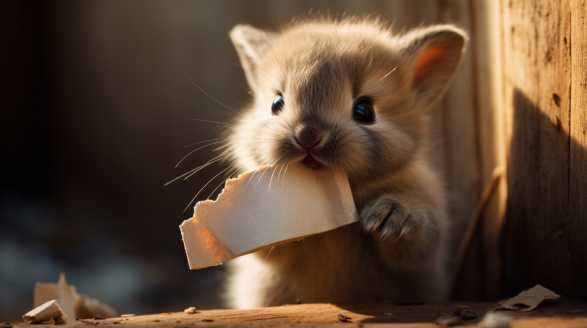
Can Rabbits Chew On Cardboard
Introduction Are you a proud rabbit owner who’s always wondered why your furry friend enjoys chewing on cardboard? Well, you’re not alone! That’s why we’ve dedicated this article to exploring the ins and outs of cardboard chewing in rabbits. We’ll dive into topics like whether it’s a sign of boredom, alternatives to cardboard, and how […]
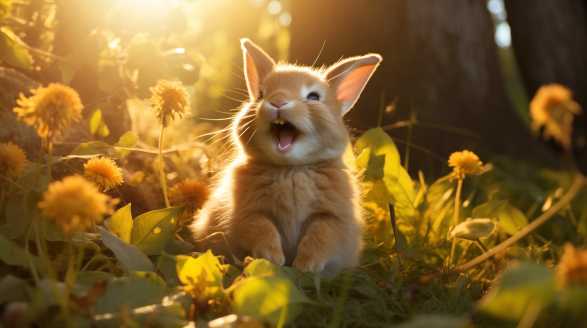
How Often Do Rabbits Poop
Introduction How often do rabbits poop? Let’s find out. Now, I know what you’re thinking – why on earth would anyone want to talk about rabbit poop? But let me tell you, my curious friend, there’s more to these tiny pellets than meets the eye. Imagine this: you find yourself pondering about the frequency at […]
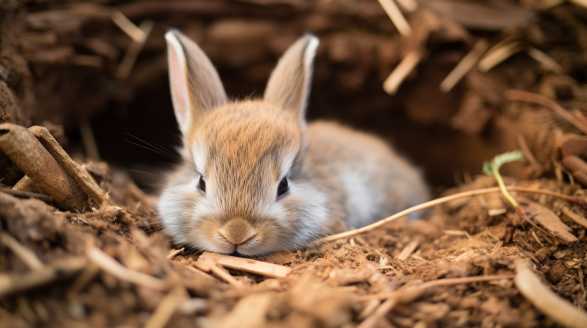
Is Aspen Bedding Safe For Rabbits
Introduction Hey there rabbit owners! Are you looking for the safest and most comfortable bedding option for your fluffy friend? we’ll be diving into the topic of aspen bedding for rabbits and exploring its safety and benefits. As a passionate rabbit owner myself, I understand the importance of choosing the right bedding material for our […]
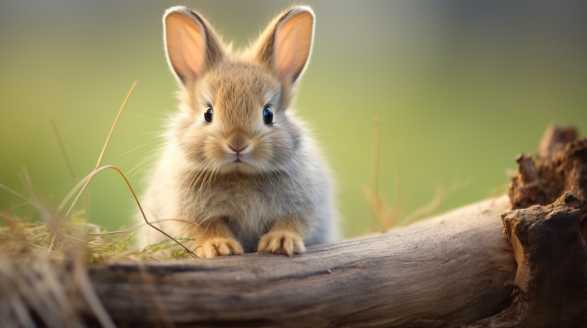
Do Rabbits Purr
Introduction Do rabbits purr? Let’s find out. Imagine this: you’re sitting in your cozy living room, cuddling with your beloved pet bunny. As you stroke its soft fur, you hear a low, rhythmic hum. Your eyes widen with curiosity as you wonder, “What does this purring mean? Is my bunny happy? Amazed by my petting […]
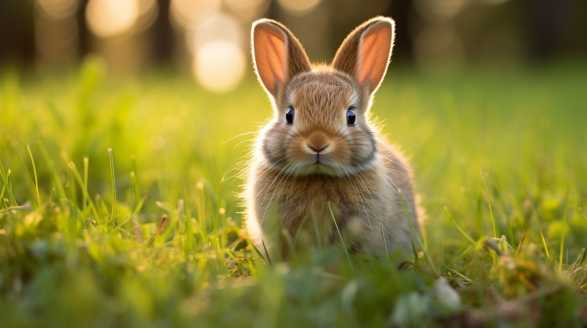
How To Stop Rabbits From Destroying Your Lawn
Introduction Hey there, fellow gardeners and lawn enthusiasts! We all love the sight of a perfectly manicured lawn, don’t we? That’s why I’m here today to share some fantastic solutions to help you reclaim your lawn from these furry invaders. we’ll explore a variety of chemical-free remedies and DIY methods to keep rabbits away from […]

Do Rabbits Nurse Their Young
Do Rabbits nurse they’re young? Let’s find out. Rabbits are adorable and fascinating creatures, known for their cute and fluffy appearance. As furry little mammals, one might wonder how rabbits ensure the survival of their offspring. Do rabbits nurse their young, similar to other mammals? In this article, we will explore the nursing behavior of […]
